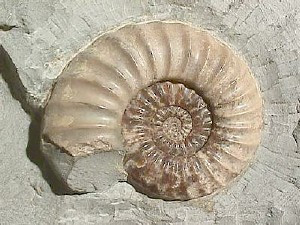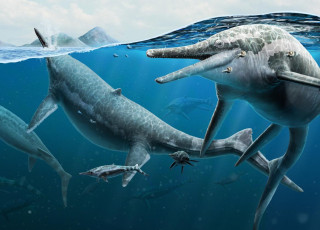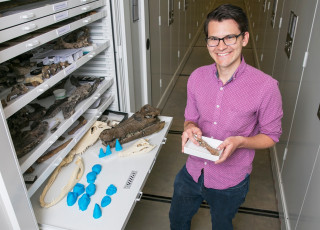Ammonoids of the Digital Sea
A representation created by the University of Utah Ammlab showing water flow around the shell as the ammonoid was swimming. ©University of Utah/Ammlab
By Nicholas Hebdon
Ammonoids are an iconic fossil. Chances are even if you didn’t know they were called ammonoids (or ammonites) you've probably seen that spiral shell in some jewelry or as part of a novelty fossil collection. These fossils belong to a group of animals called cephalopods, which includes modern-day octopi, squid, and chambered nautilus; in fact, they probably looked like a shelled squid! I say probably because we don’t have very good evidence of the soft body and all ammonoids are extinct, having died out alongside the dinosaurs at the end of the Cretaceous Period.
The fact that we only have the shells of these animals has made it difficult to learn about what they were doing and how they fit into past ecosystems. Ammonoids were a part of Earth’s oceans for over 300 million years and they were extremely plentiful and diverse during that time. This makes them important targets from a scientific perspective. If we can figure out how these animals lived and interacted with the world around them the then we have a foundation upon which we can build a better understanding of what our ancient ocean ecosystems looked like and how they responded to change through time.

One basic but important unresolved question about ammonoids: how well did they swim? A lot of work and creativity has already gone into this endeavor with past researchers recreating shells so they could submerge them in water tanks and see how these animals might have moved through the water. Here at the University of Utah’s Ammonite Motility Modeling Lab (AMM Lab), we’re taking these ideas and bringing them into the digital age where we can leverage the power of modern computer technology and software.
We start by creating 3D models of the shells we want to analyze. The nice thing about working with 3D models is that we can not only recreate existing fossils and fill in missing parts, but it’s also very easy to make shells that are different in only a limited number of ways and by only the amount we want. Being able to control precisely how different any two shells are we can build a much deeper understanding of the relationship these shells to the swimming ability of an ammonoid.
Once we’ve created the shells, we bring them into the Computational Fluid Dynamics software. This is a type of software that is traditionally used for engineering purposes and it allows us to take a deep dive into how the water moves around these shells. We have a lot of control over the environment in these simulated settings and so we can hone in on the specific details we want to learn about. Once we’re done, we’re able to create really beautiful and evocative images of how the simulations predict water flowed around the shell.
With these tools at our disposal we’re learning a lot more than we thought possible even just a few years ago when I started to work on this project. We’ve been able to show that the range of likely ammonoid swimming strategies that have been around through time are really staggering. There would have been substantial variation even in the lifetime of a single ammonoid where it might change from a more active swimmer to a slower moving and passive feeder as its shell shape changes.
The exciting part is that we’re continuing to learn how to apply these tools and develop the methods further. The more we refine how we model these interactions the more applications we see beyond ammonoids. As we begin to apply these tools to other groups (fish and squid or even extinct animals like Plesiosaurs and Mosasaurs), I’m sure we’ll start to see some impressive new discoveries in how other animals lived as well.
Nicholas Hebdon is a PhD Candidate in the Department of Geology & Geophysics at the University of Utah. The Natural History Museum of Utah, is also part of the University of Utah in Salt Lake City. Our mission is to illuminate the natural world and the place of humans within it. In addition to housing outstanding exhibits for the public, NHMU is a research museum. Learn more about NHMU.



